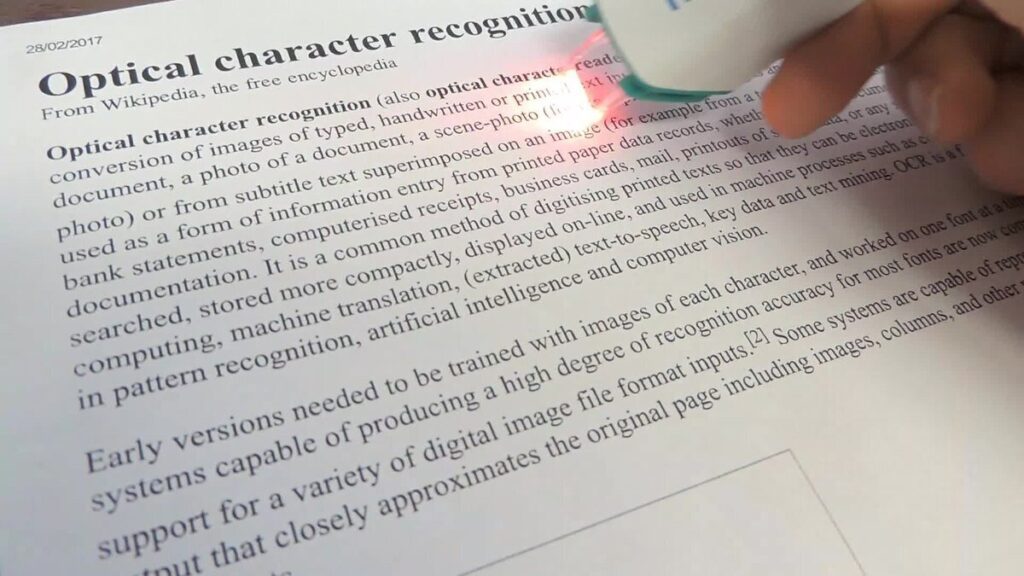Optical Character Recognition (OCR) is a technology that converts different types of documents, such as scanned paper documents, PDFs, or images captured by a digital camera, into editable and searchable data. It is widely used to digitize printed texts so that they can be electronically edited, searched, stored more compactly, and used in machine processes like cognitive computing and text mining.
How OCR Works
OCR technology typically involves several steps:
- Image Acquisition: The document is scanned using an optical scanner, converting it into a digital image.
- Preprocessing: The image is processed to improve its quality. This involves techniques like noise reduction, binarization, and skew correction.
- Text Recognition: The core OCR engine analyzes the text in the image. This can be done using various methods:
- Pattern Matching: Compares the scanned image with stored templates of characters.
- Feature Extraction: Decomposes characters into features like lines and loops, which are then compared to stored features.
- Postprocessing: The recognized text is converted into a machine-readable format, often involving spell-checking and context-based corrections.
Types of OCR Technologies
- Simple OCR: Uses pattern matching to compare text images to stored templates. This method is limited by the variety of fonts and handwriting styles it can recognize.
- Intelligent Character Recognition (ICR): Uses machine learning and neural networks to recognize text, making it more adaptable to different fonts and handwriting styles.
- Intelligent Word Recognition (IWR): Similar to ICR but processes whole words instead of individual characters.
- Optical Mark Recognition (OMR): Identifies marks, such as checkboxes or bubbles, often used in forms and surveys[2][3][5].
Popular OCR Tools
Tesseract
Tesseract is an open-source OCR engine developed by HP and now maintained by Google. It supports a wide variety of languages and can recognize text in multiple scripts. Tesseract uses a two-pass approach to improve accuracy, with the second pass refining the results from the first[3].
EasyOCR
EasyOCR is a Python-based OCR tool that supports over 80 languages. It uses deep learning models to recognize text and is known for its ease of use and high accuracy. EasyOCR can handle complex scripts and is particularly useful for recognizing text in images with varied backgrounds.
Google Vision OCR
Google Vision OCR is part of the Google Cloud Vision API. It can detect and extract text from images and videos, supporting a wide range of languages and scripts. Google Vision OCR uses advanced AI techniques to provide high accuracy and can be integrated into applications via API[1][4].
Applications of OCR
OCR technology is used in various fields, including:
- Document Digitization: Converting paper documents into digital formats for easy storage and retrieval.
- Data Entry Automation: Reducing manual data entry by automatically extracting information from forms and invoices.
- Assistive Technology: Helping visually impaired individuals by converting printed text into speech or braille.
- Text Mining and Analytics: Extracting valuable insights from large volumes of printed material[2][4][5].
In conclusion, OCR technology has revolutionized the way we handle printed documents, making it easier to digitize, search, and analyze text data. Tools like Tesseract, EasyOCR, and Google Vision OCR offer powerful solutions for various OCR applications, leveraging advanced AI techniques to provide high accuracy and efficiency.
Further Reading
1. 采用 Google AI 的 OCR | Google Cloud
2. 什么是 OCR?- 光学字符识别简介- AWS
3. Optical character recognition – Wikipedia
4. OCR meaning: What is OCR and why it’s important | Adobe Acrobat
5. What is OCR (Optical Character Recognition)? | IBM


